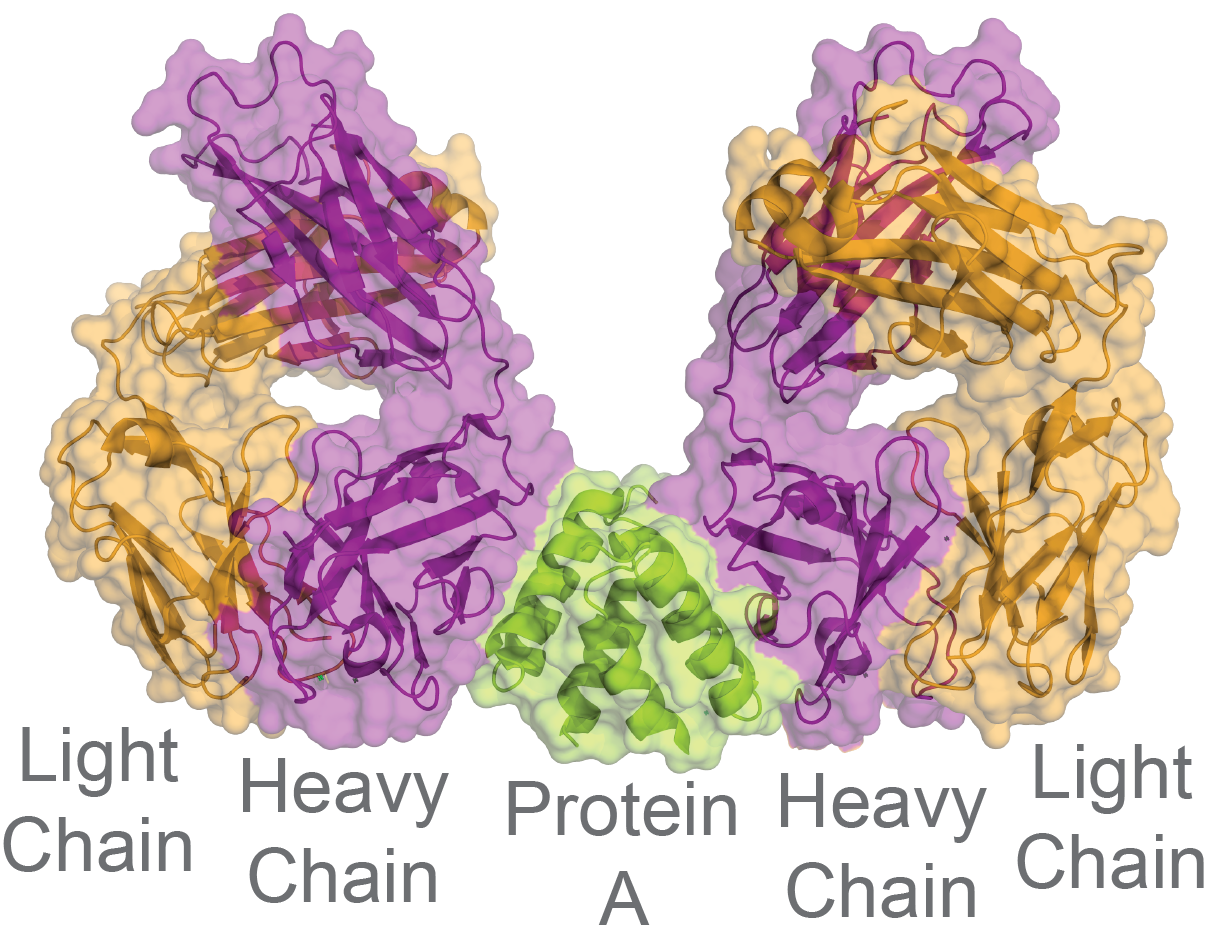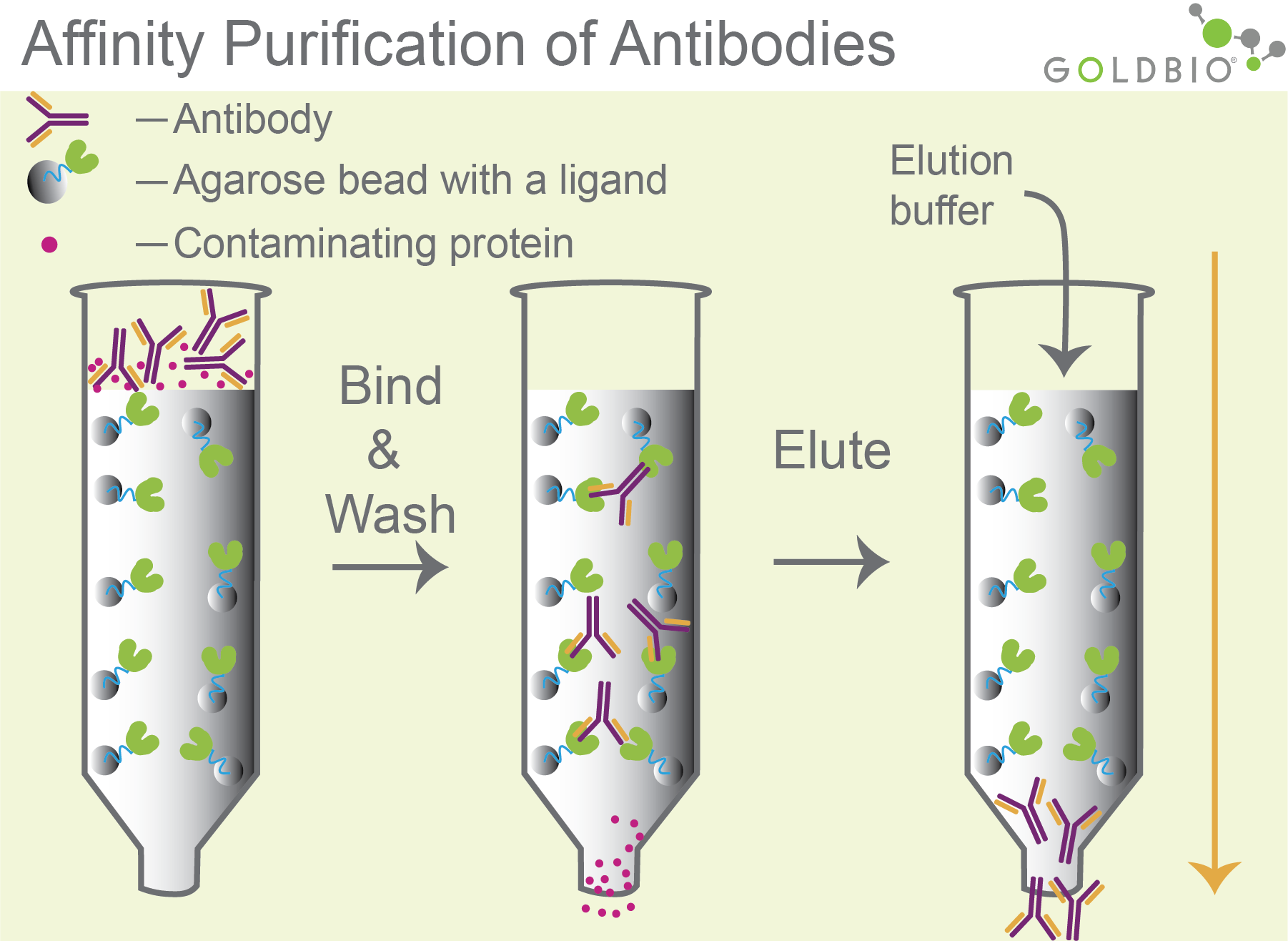All About Protein A Agarose Beads: Their Function and Uses
by Simon Currie, Ph.D.

by Simon Currie, Ph.D.
Protein A is a bacterial protein from the cell wall of Staphylococus aureus that binds to the heavy chains of antibodies. This interaction is leveraged to use Protein A for purifying antibodies and for supporting immunoprecipitation (IP) experiments.
Affinity Purification of Antibodies

Figure 1.
Protein A (green) interacting with human IgM antigen binding fragment (Fab) via
the heavy chains (purple). Light chains are colored orange (PDB: 1DEE).
Protein A binds to the heavy chains of mouse and human IgG antibodies and is a useful molecule for purifying antibodies and performing immunoprecipitation (IP) experiments (Figure 1) (Graille et al, 2000). If you need a quick refresh on antibody structure and types, check out this article really quick.
When it comes to antibody purification, antibodies are molecules that we want to purify out of a complex mixture such as animal serum or cell lysate. Traditionally protein A itself was purified from S. aureus cultures (Hjelm et al, 1972). However recombinant protein A expressed in Escherichia coli is frequently used today.
But antibodies can also be used to help purify other proteins, which is the case when doing immunoprecipitation experiments.
To purify antibodies, native or recombinant protein A is conjugated to agarose beads. Antibody-containing solutions are then loaded onto a protein A column. After washing, the antibodies are then eluted by adding buffer with acidic pH (pH <3) (Figure 2).

Figure 2. Antibody
purification. Antibodies bind to agarose beads with an interacting partner
molecule such as protein A (middle column). After washing (middle column),
antibodies are eluted with an acidic pH elution buffer that weakens the
interaction between the antibody and protein A (column 3).
With Protein A, you can use a pH gradient to separate different antibodies in a polyclonal mixture (Sheng and Kong, 2012). That is to say, instead of doing a one-step elution, you can slowly change the pH in order to separate different antibodies from one another (Figure 3). Check out this article for more information about eluting antibodies.
Antibodies have poor long-term stability in acidic conditions, so the eluted antibodies are then pH adjusted back to neutral values (~ pH 7 to 8).

Figure 3.
Depiction of one-step elution (left) versus gradient elution (right). Protein A
is particularly useful for separating different antibody species using a
gradient elution.
Immunoprecipitation (IP) experiments use an antibody to bind to a particular protein and see what else is interacting with that particular protein.
Protein A beads are especially useful for IP experiments because they serve as a platform to anchor the antibody to. First, the antibody is loaded onto Protein A beads. Then, cell extract, or another type of biochemical mixture that contains that particular protein is exposed to the antibody-loaded Protein A beads. That specific protein, and anything else binding to the specific protein, will stick to the antibody on the beads and will be eluted later. In contrast, proteins that don’t interact with the antibody-bound protein will flow through the beads before the elution (Figure 4).

Figure 4. IP
experiment – Protein A (light green) binds to an antibody (purple and orange).
The antibody anchors a specific protein (blue diamond), and this setup is used
to discover new interacting molecules (dark green oval).
This type of experiment is commonly used to discover and verify protein-protein interactions that happen in cells. For more information about IP experiments and how Protein A agarose enables these foundational experiments.
So there you have it – that’s all about Protein A’s function and uses in antibody purification and immunoprecipitation experiments. See the links below for related material about Protein A, and for more information about GoldBio’s Protein A agarose products.
All About Affinity Purification of Antibodies
Protein A and Protein G Troubleshooting Guide
Affinity Comparison of Protein A and Protein G for Various Antibody Classes

Competent cells such as DH5a, DH10B, and BL21 will maintain their transformation efficiency for at least a year with proper storage. It is important to...

Ni2+ ions give nickel agarose beads their characteristic blue color. This blue color can fade or disappear completely when loading his-tagged proteins onto the column....

Nickel agarose beads change from blue to a brown or black color when the nickel ions have been reduced from a Ni2+ to a Ni1+...

The GoldBio Floating Tube Rack is one of our more clever giveaways because of the unique purpose it serves. And, with it also being one...
